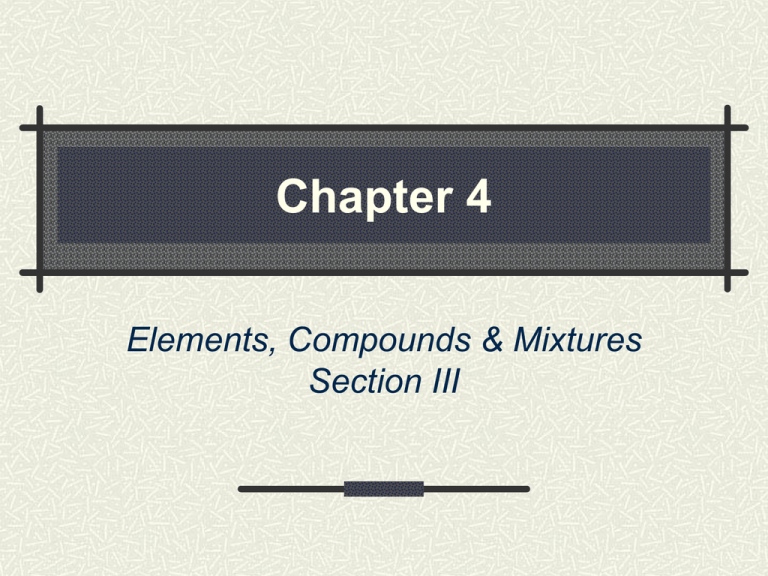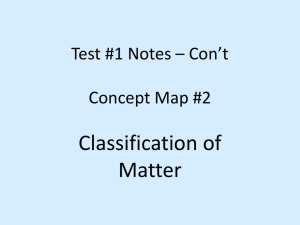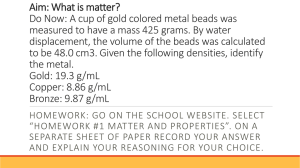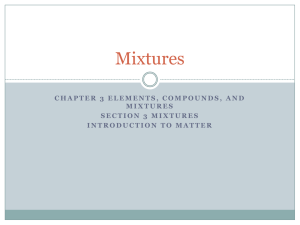Section 3 - Mixtures
advertisement

Chapter 4 Elements, Compounds & Mixtures Section III Section 3 - Mixtures III. MIXTURES A. Properties of mixtures – A Mixture is a combination of chemical substances that are not chemically combined. 1. Substances in a mixture retain their identity. a. In some mixtures you can see the individual pieces (pizza). Introductory movie Section 3 - Mixtures b. In other Mixtures you cannot see all of the components (Salt water). lemonade Pizza dough http://www.eriding.net/media/photos/design_tech/food/050114_rfoster_mp_dt_food_dough3.jpg Section 3 - Mixtures 2. Mixtures can be physically separated. a. Picking the pieces of the mixture apart. Either by hand for big particles (pizza) or by a filter for medium sized particles. (Coffee grounds) or distillation (for really small particles) Section 3 - Mixtures c. Magnets- can sort out metals that can be magnetized. d. Density - can be used to separate mixtures. By adding water if one of the items has a density less than water or Centrifuge-can spin items of different in to layers. e. Some mixtures need to be separated using several steps. http://www.teach-nology.com/web_tools/science_lab/centrifuge.gif http://www.twpg.com.au/Retail/images/magnets1.gif Section 3 - Mixtures 3. The components of a mixture do not have a definite ratio. a. The amount of things in a mixture does not matter. b. The air is made of nitrogen, oxygen and other gases including water. Some days the air has more water than others. Air is a mixture. Section 3 - Mixtures B. Solutions1. A solution is a mixture that appears to be a single substance but is composed of particles of two or more substances distributed evenly amongst each other. The pieces of the mixture are VERY small. So small that they cannot be seen, filtered or even reflect light Section 3 – Mixtures a. Because it has the same appearance and properties through out the mixture it is often described as a homogeneous mixture. b. The process in which the particles separate and spread evenly throughout a mixture is called dissolving. c. The solute is the substance that is dissolved and the solvent is the substance the solute is dissolved in. Solutions movie d. A solute is soluble or able to dissolve. If a substance is insoluble it will form a mixture that is not homogeneous and therefore is not a solution. Section 3 - Mixtures e. If two liquids or two gasses combine to form a solution the substance with the greater volume is the solvent. f. Alloys are solid solutions of metals or non metals dissolved in metals. For example brass is an alloy of Zinc dissolved in copper. http://www.grybmusic.com/percussion/Percussion%20Photos/P7110056%20brass%20jingle%20bells.jpg Brass Alloy Video-Unitedstreaming This is an alloy of indium Gallium and tin that is a liquid at room temperature Section 3 - Mixtures 2. Particles in solutions are extremely small. So small that they never settle out, cannot be filtered out and they do not even scatter light. 3. Concentration is a measure of how much solute is dissolved in the solvent. Deep concentration! http://shopping.animazing.com/gallery/willardson_04/art/small/images/5051080%20The%20Picture%20Of%20Concentration%20%23%2014-2%20(S%200503)%2011.75x8.5.jpg Section 3 - Mixtures b. Solutions can be described as concentrated or dilute but these are not specific descriptions. c. A solution that contains all the solute it can hold at a given temperature is said to be saturated. An unsaturated solution contains less than it can hold. Section 3 - Mixtures 4. Solubility of a solute is the amount of solute needed to make a saturated solution using a given amount of solvent at a certain temperature. a. Solubility is expressed in grams of solute per 100mL of solvent. b. There is a solubility chart on p 95. c. The solubility of gasses in liquids decreases as temperature is raised SOLUBILITY CHART FROM TEXT Section 3 - Mixtures 5. What effects how fast a solid dissolves? a. Mixing- stirring or shaking helps particles separate and mix with the solvent. b. Heating- causes particles to move more quickly causing solvent to spread out and mix with solvent. c. Crushing- increases the amount of contact between the solute and the solvent. Allowing the solvent to dissolve more quickly. Section 3 - Mixtures crushing http://altura.speedera.net/ccimg.catalogcity.com/220000/226000/ 226022/products/lg_9403112.jpg Mixing http://www.darkdarling.com/photos/stirring.jpg Heating http://www.american.edu/ted/images4/heating.GIF Section 3 - Mixtures C. Suspensions- a mixture in which particles are dispersed throughout the liquid or the gas but are large enough that they settle out. Suspension Video-Courtesy Unitedstreaming 1. The particles are insoluble so they do not dissolve. 2. Suspensions are usually described as heterogeneous mixtures (video). Because the different components are easily seen. Section 3 - Mixtures 3. Characteristics of suspensions: a. Particles are fairly large and they scatter or block light. b. Particles are too heavy to stay mixed without being stirred or shaken. c. Passing it through a filter can separate a suspension. Section 3 - Mixtures D. Colloids-a mixtures in which the particles are dispersed through out but are not heavy enough to settle out. Colloid Video-Unitedstreaming 1. Colloids have properties of both solutions and suspensions. 2. The particles in a colloid are large enough to scatter a beam of light. 3. The particles in a colloid cannot be filtered out of the mixture. Section 3 - Mixtures Examples of colloids include- milk, gelatin, whipped cream, deodorant, and mayonnaise. Photos courtesy google.com Build comparison 5 block chart Note to Mrs. Martin remember that they have difficulties comparing the substances re teach how this goes so the tests will be ok









